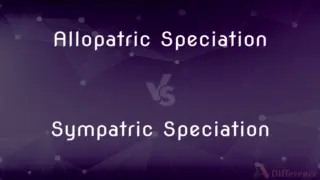EPSP vs. IPSP — What's the Difference?
By Tayyaba Rehman — Published on December 17, 2023
EPSP is an excitatory post-synaptic potential, making a neuron more likely to fire; IPSP is an inhibitory post-synaptic potential, making it less likely to fire.

Difference Between EPSP and IPSP
Table of Contents
ADVERTISEMENT
Key Differences
EPSP stands for excitatory post-synaptic potential. This is a temporary increase in a neuron's membrane potential, making it more positive and thus closer to the threshold for firing an action potential. On the other hand, IPSP stands for inhibitory post-synaptic potential. This represents a temporary decrease in the membrane potential, pushing the neuron further from the threshold and making it less likely to fire.
When an EPSP occurs, it results from the opening of channels that allow positive ions to enter the neuron, making the inside more positive. Conversely, an IPSP is due to the opening of channels that let negative ions into the neuron or positive ions out, making the inside more negative.
EPSP and IPSP can occur simultaneously in a neuron, resulting from inputs from multiple sources. While EPSPs push the neuron towards firing an action potential, IPSPs work against this, effectively counteracting the excitatory influence.
It's important to understand that both EPSP and IPSP are graded potentials. This means their magnitude can vary depending on the strength of the stimulus. While multiple EPSPs can add up to reach the threshold for action potential, IPSPs can negate this cumulative effect.
Both EPSP and IPSP play critical roles in the complex interplay of signals in the brain. While EPSP promotes neuronal activity, IPSP keeps it in check, ensuring a balance in neural responses.
ADVERTISEMENT
Comparison Chart
Meaning
Excitatory Post-Synaptic Potential
Inhibitory Post-Synaptic Potential
Effect on Neuron
Makes a neuron more likely to fire
Makes a neuron less likely to fire
Ion Movement
Positive ions enter neuron
Negative ions enter or positive ions leave
Result on Potential
Increases membrane potential
Decreases membrane potential
Role
Promotes neuronal activity
Keeps neuronal activity in check
Compare with Definitions
EPSP
Represents excitatory neural input.
The synapse delivered an EPSP, indicating excitatory input.
IPSP
A graded potential that can vary in size.
The stimulus caused a minor IPSP, slightly inhibiting the neuron.
EPSP
A result of positive ion influx into the neuron.
Due to the EPSP, more positive ions entered the neuron.
IPSP
Counteracts the effects of EPSPs.
Even with several EPSPs, the IPSP prevented the neuron from firing.
EPSP
Can combine with other EPSPs to reach action potential threshold.
Multiple EPSPs accumulated, leading the neuron to fire.
IPSP
A result of negative ion influx or positive ion efflux from the neuron.
The IPSP resulted in more negative ions entering the neuron.
EPSP
A potential that increases a neuron's likelihood to fire.
The neuron experienced an EPSP, bringing it closer to the firing threshold.
IPSP
A potential that decreases a neuron's likelihood to fire.
The neuron experienced an IPSP, pushing it away from the firing threshold.
EPSP
A graded potential that can vary in magnitude.
The neuron received a strong stimulus, causing a larger EPSP.
IPSP
Represents inhibitory neural input.
The synapse introduced an IPSP, indicating an inhibitory signal.
Common Curiosities
Can both EPSP and IPSP occur in the same neuron simultaneously?
Yes, both EPSP and IPSP can occur in the same neuron due to inputs from multiple sources.
Are EPSP and IPSP considered graded potentials?
Yes, both EPSP and IPSP are graded potentials and can vary in magnitude.
What does IPSP stand for?
IPSP stands for Inhibitory Post-Synaptic Potential.
How does an EPSP affect a neuron's firing potential?
EPSP makes a neuron more likely to fire an action potential.
How does an IPSP impact a neuron's action potential?
IPSP makes a neuron less likely to fire an action potential.
How do EPSP and IPSP interact when they co-occur?
EPSPs push the neuron towards firing, while IPSPs counteract this excitatory influence.
Are EPSP and IPSP exclusive to specific brain regions?
No, both EPSP and IPSP can be found throughout the nervous system, wherever synapses are present.
What does EPSP stand for?
EPSP stands for Excitatory Post-Synaptic Potential.
Which ions are associated with EPSP?
EPSP is associated with the influx of positive ions into the neuron.
What ions are related to IPSP?
IPSP involves the entry of negative ions into the neuron or the exit of positive ions.
What's the main difference between EPSP and IPSP?
EPSP is excitatory and brings the neuron closer to firing, while IPSP is inhibitory and pushes the neuron away from firing.
How do EPSP and IPSP influence synaptic transmission?
EPSP facilitates synaptic transmission by promoting firing, while IPSP dampens it by inhibiting firing.
How critical are EPSP and IPSP in neural signaling?
Both are crucial for maintaining a balance in neural responses, ensuring neither excessive excitability nor inhibition.
Which potential promotes neural activity?
EPSP promotes neuronal activity.
Which potential inhibits neural activity?
IPSP inhibits or counteracts neuronal activity.
Share Your Discovery

Previous Comparison
Summer Olympics vs. Winter Olympics
Next Comparison
Allopatric Speciation vs. Sympatric SpeciationAuthor Spotlight
Written by
Tayyaba RehmanTayyaba Rehman is a distinguished writer, currently serving as a primary contributor to askdifference.com. As a researcher in semantics and etymology, Tayyaba's passion for the complexity of languages and their distinctions has found a perfect home on the platform. Tayyaba delves into the intricacies of language, distinguishing between commonly confused words and phrases, thereby providing clarity for readers worldwide.













































